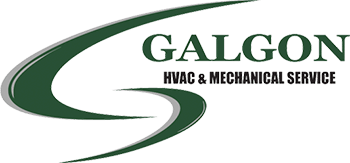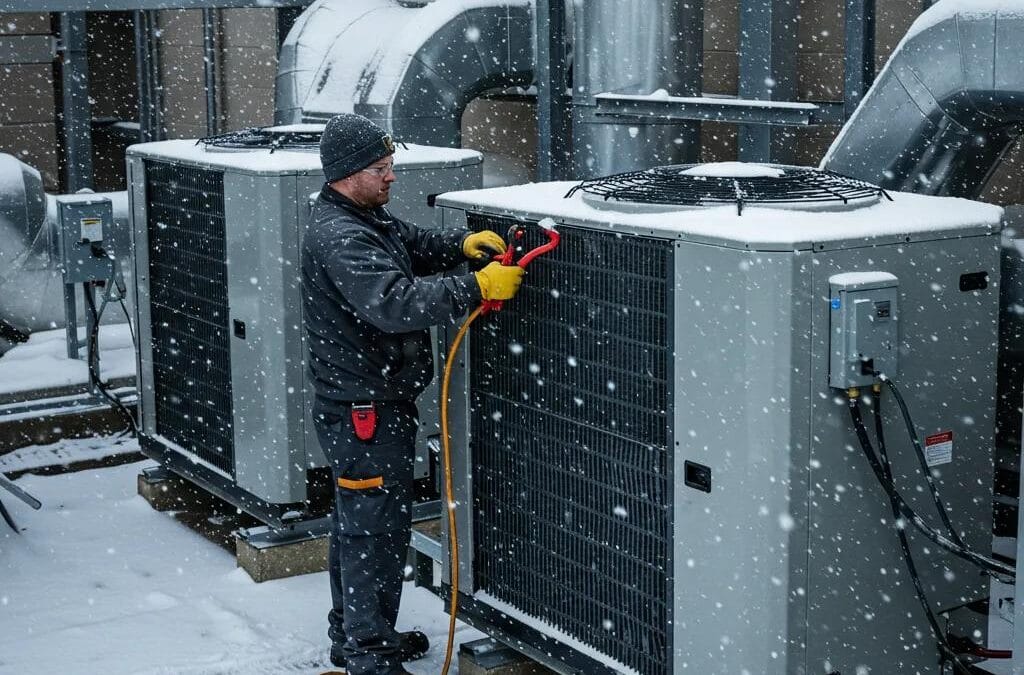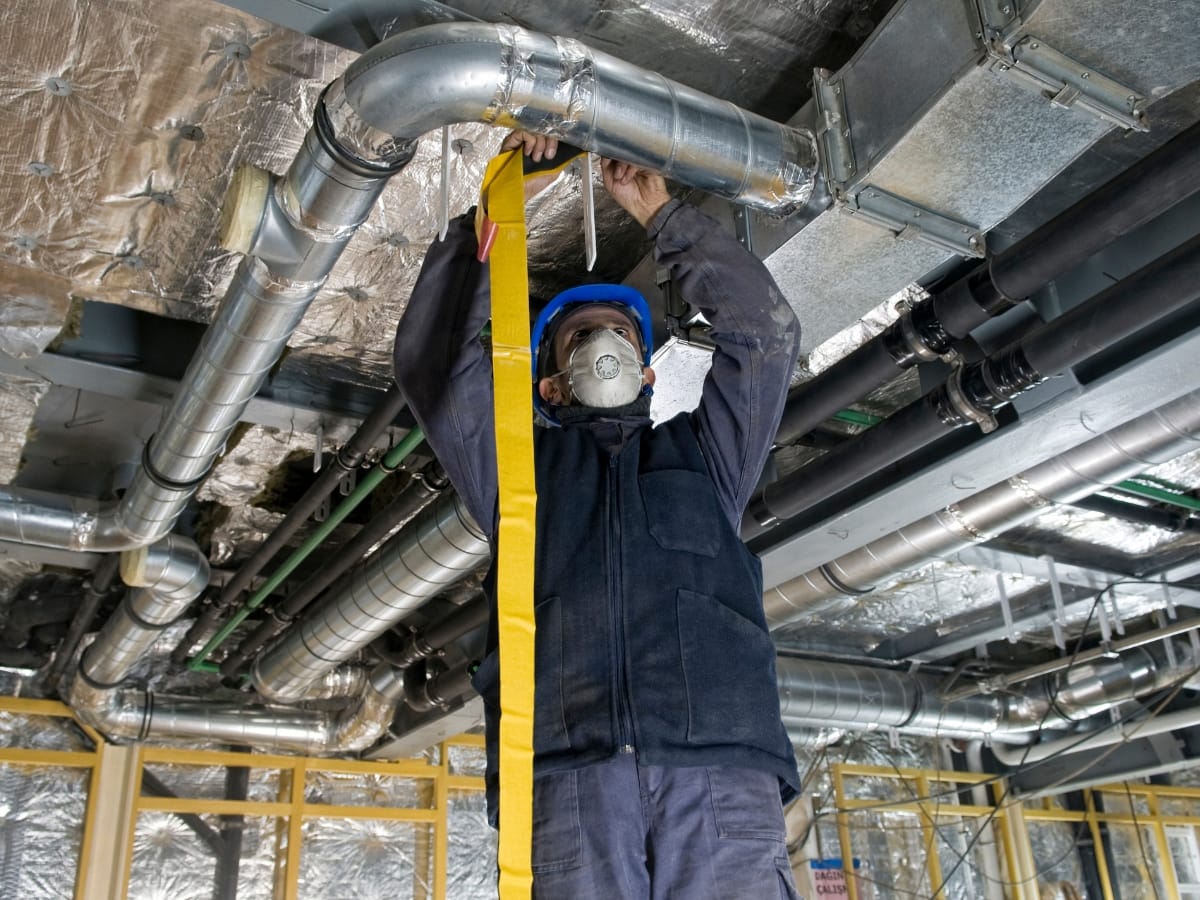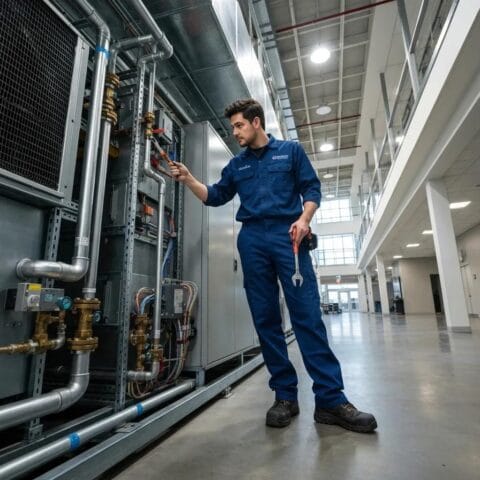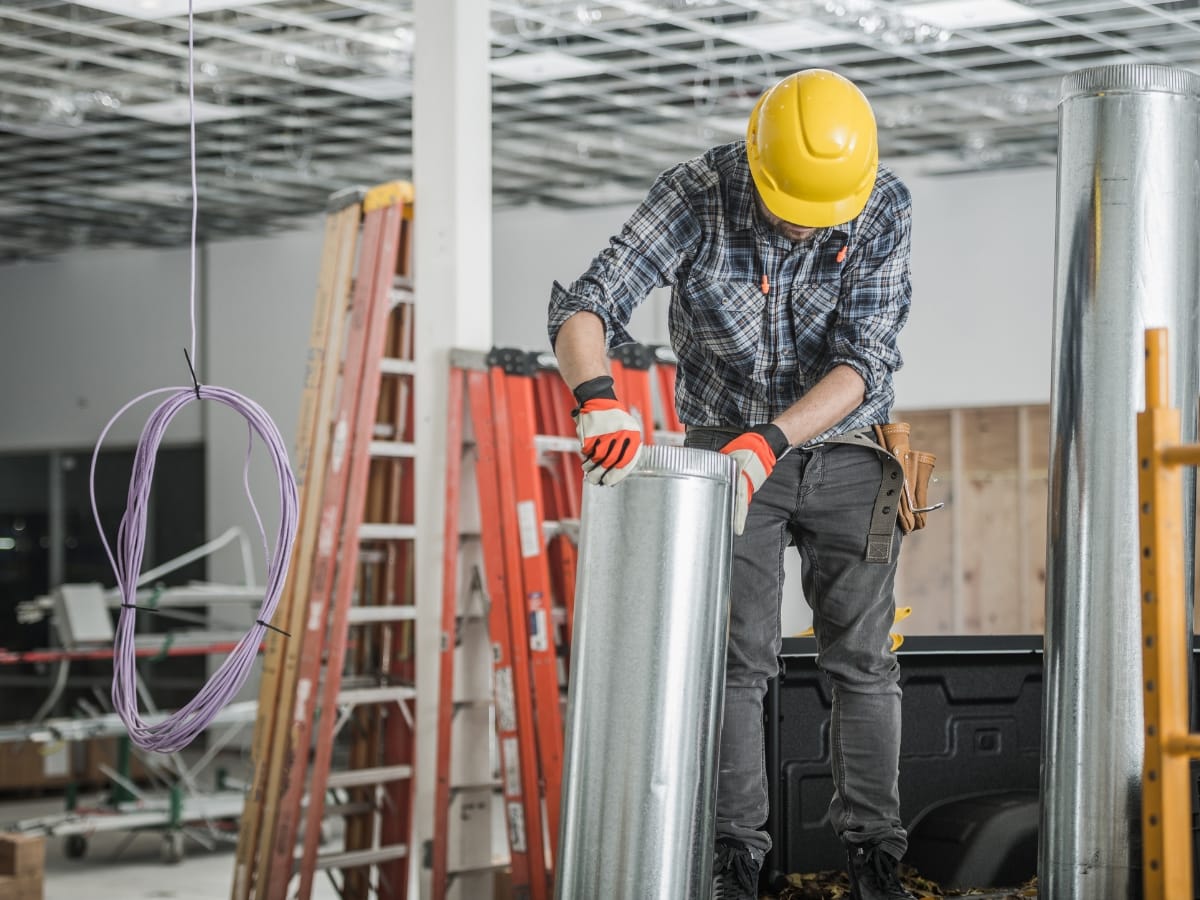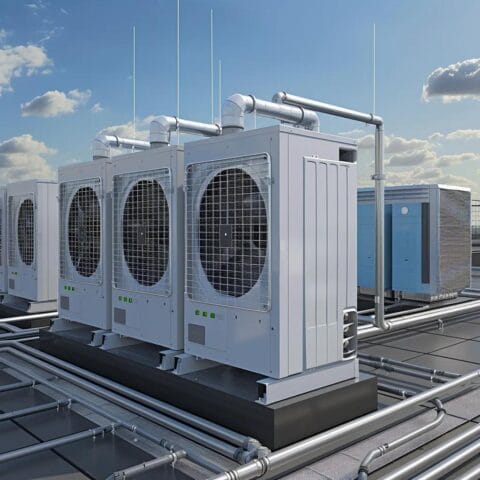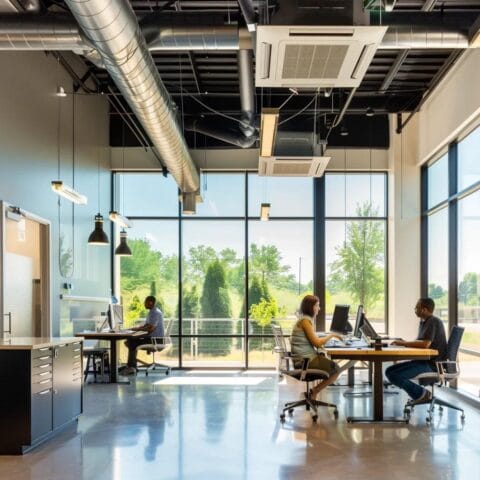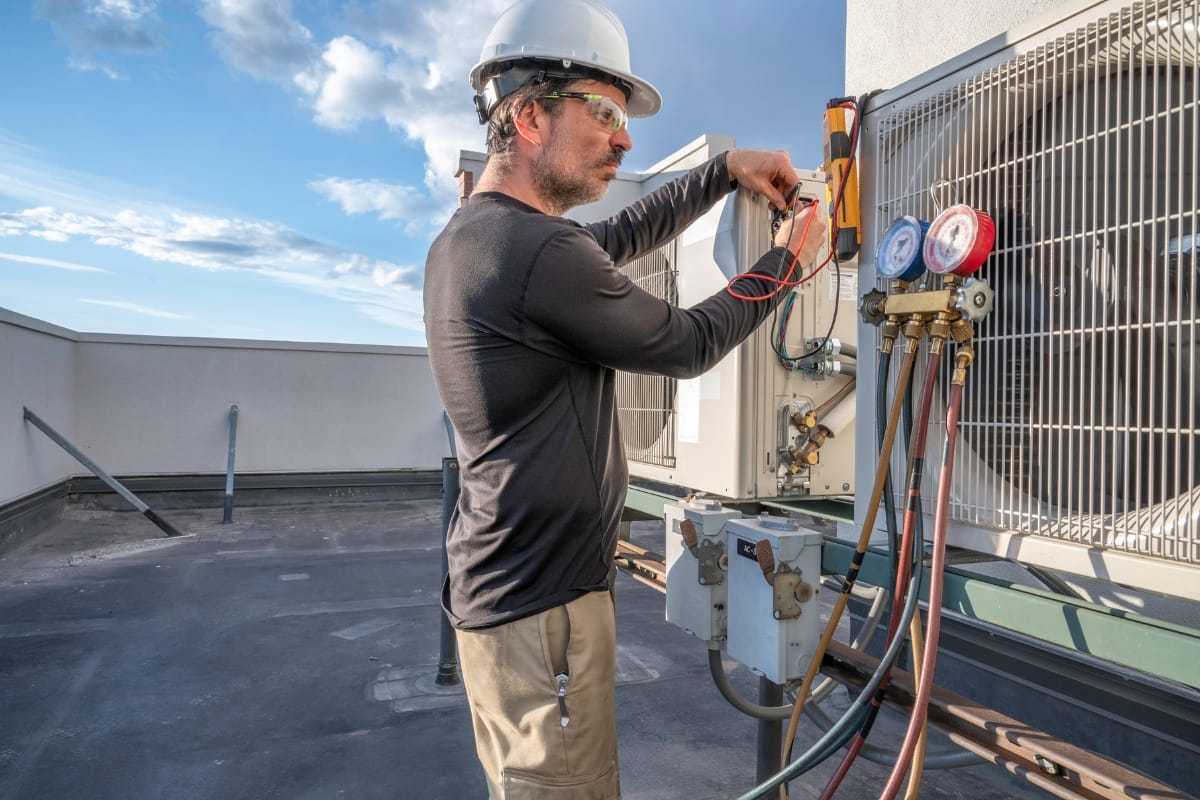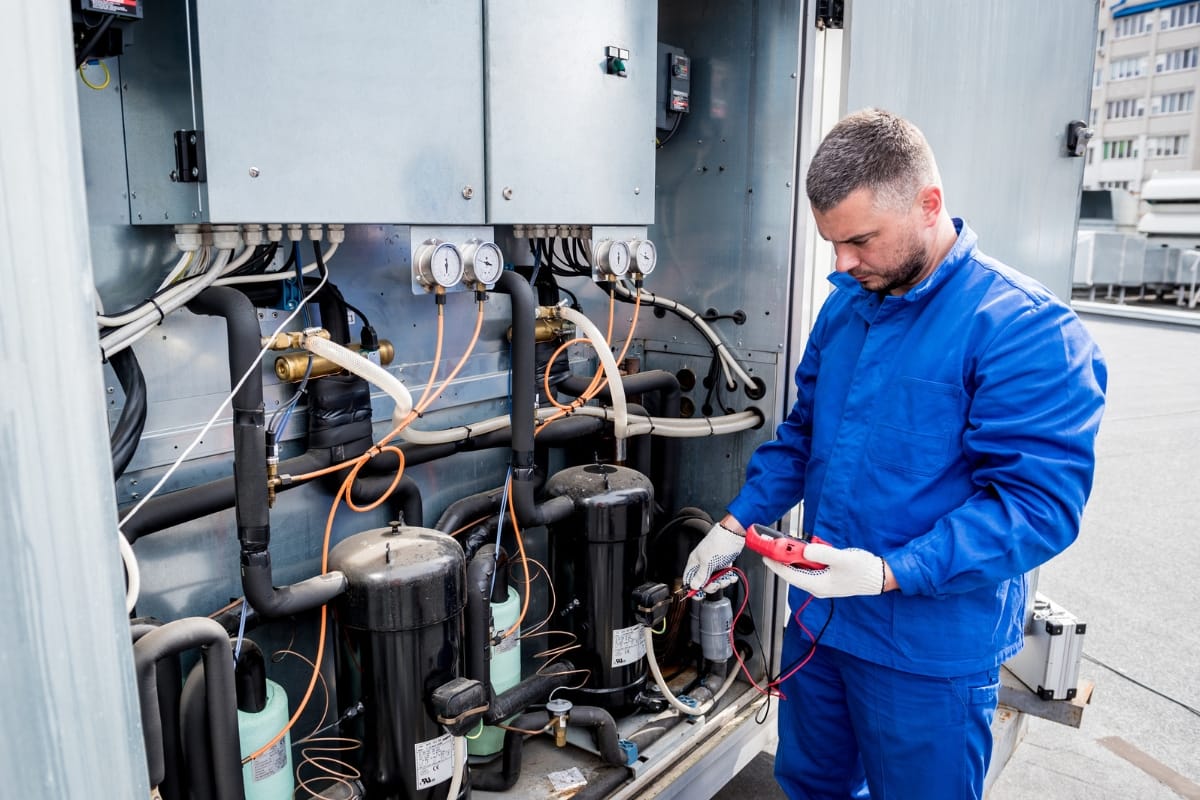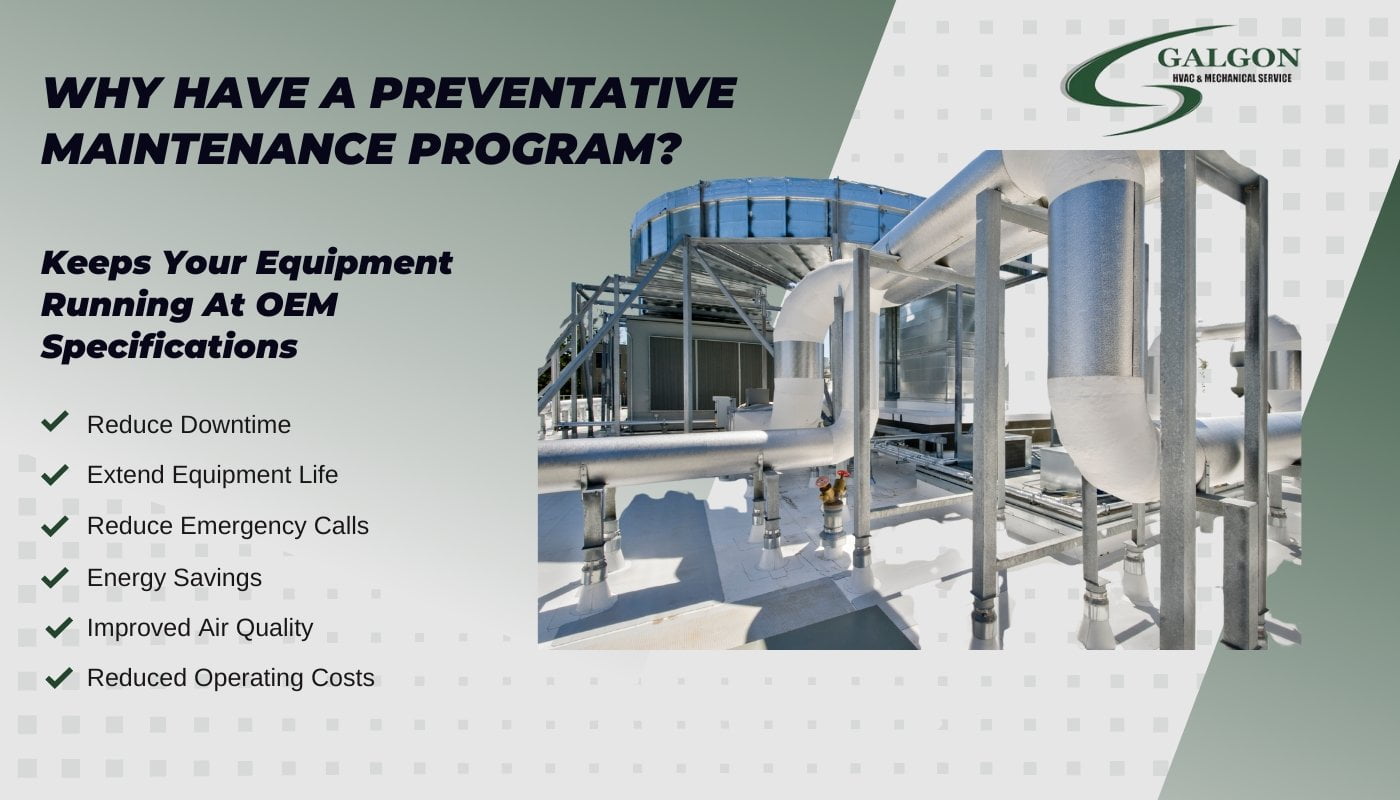As Atlanta’s winter approaches, proactive HVAC winterization for commercial buildings becomes essential to maintaining operational efficiency, tenant comfort, and cost control throughout the colder months. A non-winterized system can lead to unexpected breakdowns, soaring energy bills, and even frozen components that disrupt business activities and compromise indoor air quality. In this guide, we’ll outline the key steps involved in commercial HVAC winterization—from inspecting heat exchangers and calibrating thermostats to ensuring proper insulation and ventilation—so you can protect your investment, reduce downtime, and keep your building running smoothly all season long.
HVAC Winterization Made Easy: A Step-by-Step Guide
Why Commercial HVAC Winterization is Crucial for Atlanta Businesses
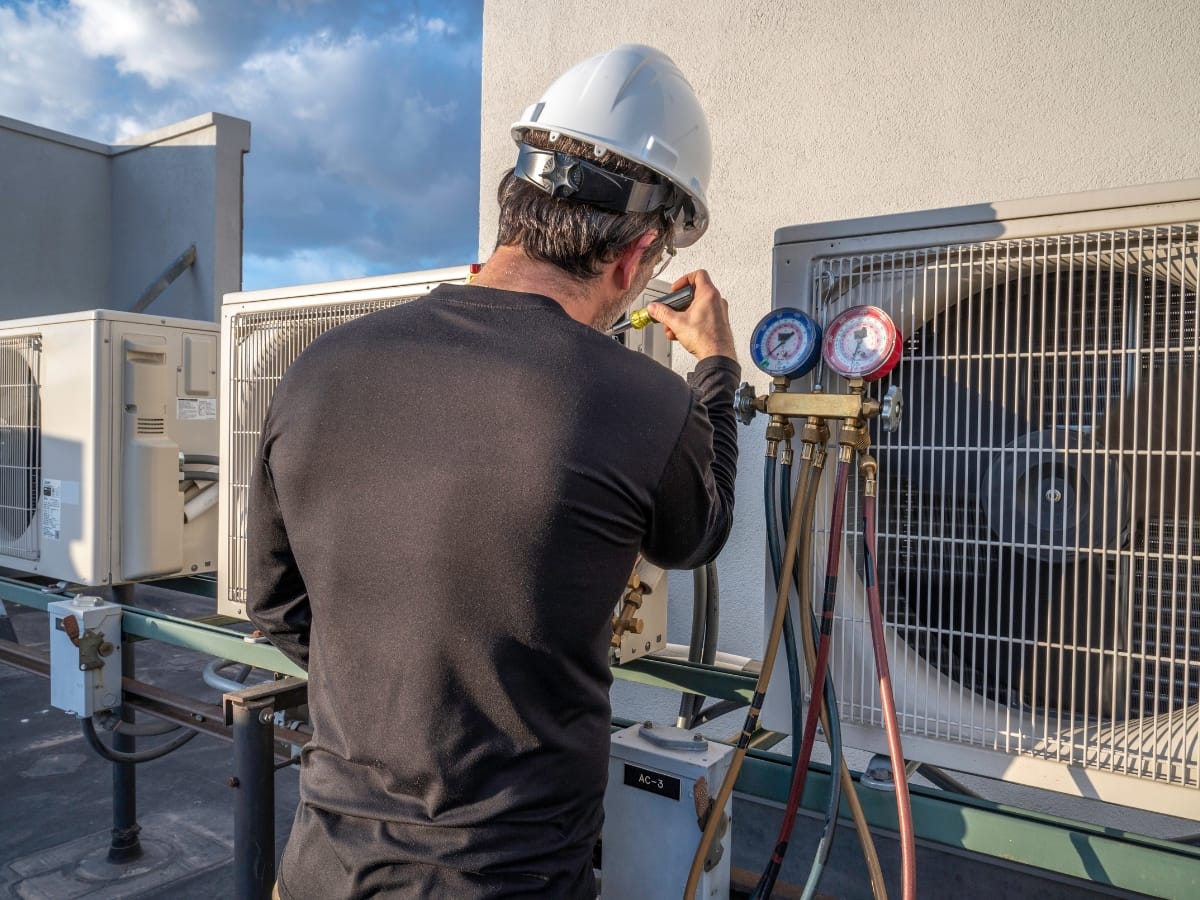
Commercial HVAC winterization prepares heating, ventilation, and air conditioning systems for cold snaps so they run safely and efficiently. Atlanta’s winters can swing from mild to freezing in a day, which stresses equipment and exposes weak links. A focused winterization plan lowers the chance of breakdowns, extends equipment life, and keeps energy costs predictable. The payoff shows up in steadier indoor comfort, fewer emergency calls, and less disruption to daily operations.
Key Benefits For Commercial Buildings
Winterization supports four business priorities. First, energy efficiency improves when leaks are sealed, coils are clean, and controls are set correctly, which reduces heat loss and shortens run times. Second, equipment reliability increases because technicians catch worn belts, cracked heat exchangers, or failing motors before they become outages.
Third, operational continuity improves since proactive repairs are scheduled, not urgent. Finally, comfort and safety rise with calibrated thermostats, verified sensor readings, and combustion safety checks that protect employees and visitors.
How Winterization Boosts Energy Efficiency And Cuts Costs
Small fixes deliver big gains. Sealing duct joints stops heated air from leaking into mechanical rooms or ceiling cavities. Cleaning evaporator and condenser surfaces restores heat transfer, so the system reaches the setpoint without long cycles. Calibrating thermostats and building automation schedules aligns heating output with actual occupancy, which prevents unnecessary runtime during off-hours.
Tuning economizers, verifying damper operation, and checking insulation on hot water piping further reduce load. Together, these steps can trim heating energy use by up to 20 percent, which is meaningful on multi-tenant floors or large retail spaces.
Risks Atlanta Buildings Face Without Proper Winterization
Skipping preparation leaves facilities exposed to avoidable problems. Uninsulated or poorly insulated pipes near exterior walls can freeze during overnight lows, leading to bursts, water damage, and downtime. Dirty burners or misaligned ignition components can cause nuisance lockouts just when demand spikes.
Leaky ducts and fouled filters force longer cycles, which can raise winter energy bills by 15 to 30 percent. Even comfort suffers, with cold zones near entrances and overheated interior rooms as systems struggle to balance airflow.
A Practical Winterization Checklist For Facility Teams
- Start with a full system inspection, then address air movement, heat delivery, and controls.
- Replace or clean filters to restore airflow, document static pressure, and verify fan belts and bearings. Inspect ductwork for visible gaps at seams and connections, seal with mastic or UL-rated foil tape, and confirm insulation on runs that cross unconditioned areas.
- Clean heat exchangers and coils, then verify if temperature rise is within manufacturer range. Test safeties, including high limits and flame sensors, and confirm carbon monoxide levels are safe in spaces with combustion appliances.
- Check hydronic components by insulating exposed piping, confirming glycol concentration if used, and testing relief valves and pumps.
- Calibrate thermostats, review time-of-day schedules, and match occupied setpoints to actual business hours.
- Finally, walk the building to note drafts at doors and loading areas, adjust vestibules and air curtains, and add weatherstripping where needed.
Planning And Documentation Make Winterization Repeatable
Create a simple log that records filter changes, coil cleaning dates, static pressure readings, refrigerant or glycol data, and thermostat schedules. Keep photos of sealed ducts and insulated piping so next season’s team can verify conditions quickly. When paired with a short mid-season check, this documentation helps maintain the gains from HVAC winterization, keeps comfort consistent during cold snaps, and holds energy costs in line for the rest of the season.
Comprehensive HVAC Winterization Checklist for Commercial Buildings
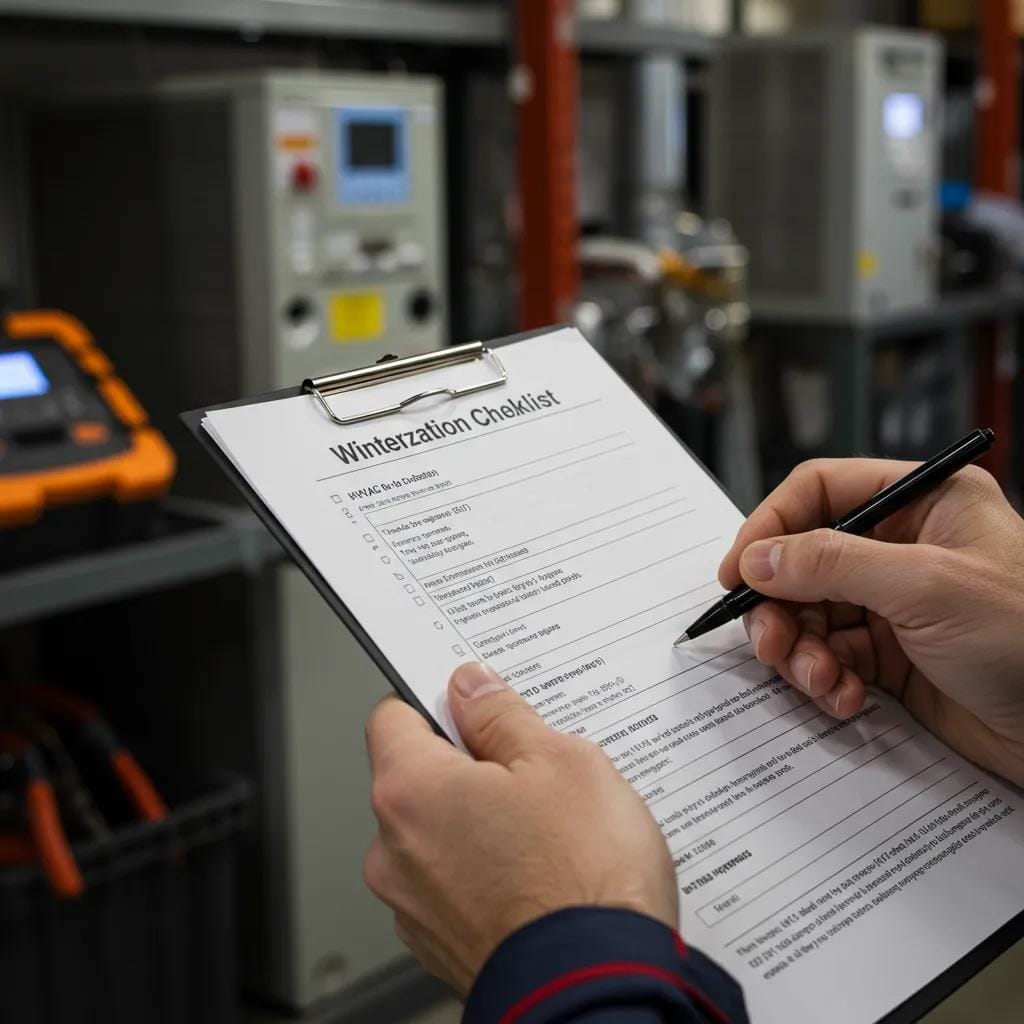
A thorough checklist for HVAC winterization prepares every subsystem for cold weather and peak demand. The aim is simple: reliable heat, steady airflow, and controlled energy use. Replacing clogged filters restores circulation and helps indoor air quality, while visual inspections catch small issues before they become mid-season shutdowns. Documenting findings and dates creates a record you can repeat each year.
Inspecting And Maintaining Air Filters, Ductwork, And Coils
Start with airflow. Filters should be replaced or cleaned so the system does not struggle to move air through the building. A minimum MERV-8 rating is a practical baseline for many commercial spaces, but follow manufacturer guidance for specialized environments. Next, examine duct seams and connections for gaps and loose fittings. Seal joints with UL-approved mastic or metal tape and verify insulation on runs that pass through unconditioned spaces. Finish with coil care. Clear debris from evaporator and condenser surfaces, then clean coils to restore heat transfer. If microbial growth has been an issue, apply an approved antimicrobial treatment during cleaning and confirm condensate drains are open.
Essential Heating System Steps For Furnaces, Boilers, And Heat Pumps
Heating equipment deserves focused attention. For furnaces, inspect burners for uniform flame, test ignition and flame-sensing controls, confirm flue integrity, and measure temperature rise to ensure it is within the manufacturer’s range. Boilers benefit from a sediment flush, verification of pressure and expansion tank settings, checks of relief valves, and a close look at heat exchangers and pump operation. Heat pumps need a reverse-cycle test, confirmation of refrigerant charge, clean outdoor coils, and a functional defrost cycle so ice cannot accumulate. Protective covers for outdoor units are helpful when designed for active airflow; do not block intake or exhaust.
Protecting Plumbing And Pipes Against Freezing And Leaks
Pipes near exterior walls, loading docks, or unheated mechanical rooms are vulnerable when temperatures drop overnight. Exterior water lines respond well to closed-cell foam wraps and heat tape with integral thermostats. Indoor supply risers stay stable with fiberglass insulation paired with a vapor barrier to control condensation. Drain lines and traps benefit from insulation jackets that limit sweating above occupied spaces. Trace particularly cold sections, note recurring trouble spots, and add signage so seasonal staff can identify shutoff points during a cold snap. These steps reduce freeze risk and the water damage that follows a burst.
Why Thermostat Calibration And Smart Controls Matter
Accurate temperature control protects comfort and budgets. Calibrate thermostats and verify sensor placement away from drafts, sun, and heat sources. Align occupied, standby, and unoccupied setpoints with real schedules so systems are not heating empty floors. Smart controls and building automation can stage equipment, manage setbacks by zone, and alert teams when temperatures drift or filters load up. Remote monitoring allows quick adjustments during weather swings, and trend data highlights rooms that need balancing or envelope fixes.
Bringing It All Together
The strongest winter plan handles airflow first, confirms safe and efficient heat delivery, protects water lines, and locks in control settings that match occupancy. With a repeatable checklist and clear records, commercial teams keep energy use predictable, reduce emergency calls, and maintain consistent comfort all season. That is the practical value of HVAC winterization for Atlanta operations.
How HVAC Winterization Prevents Frozen Pipes and Costly Water Damage in Atlanta
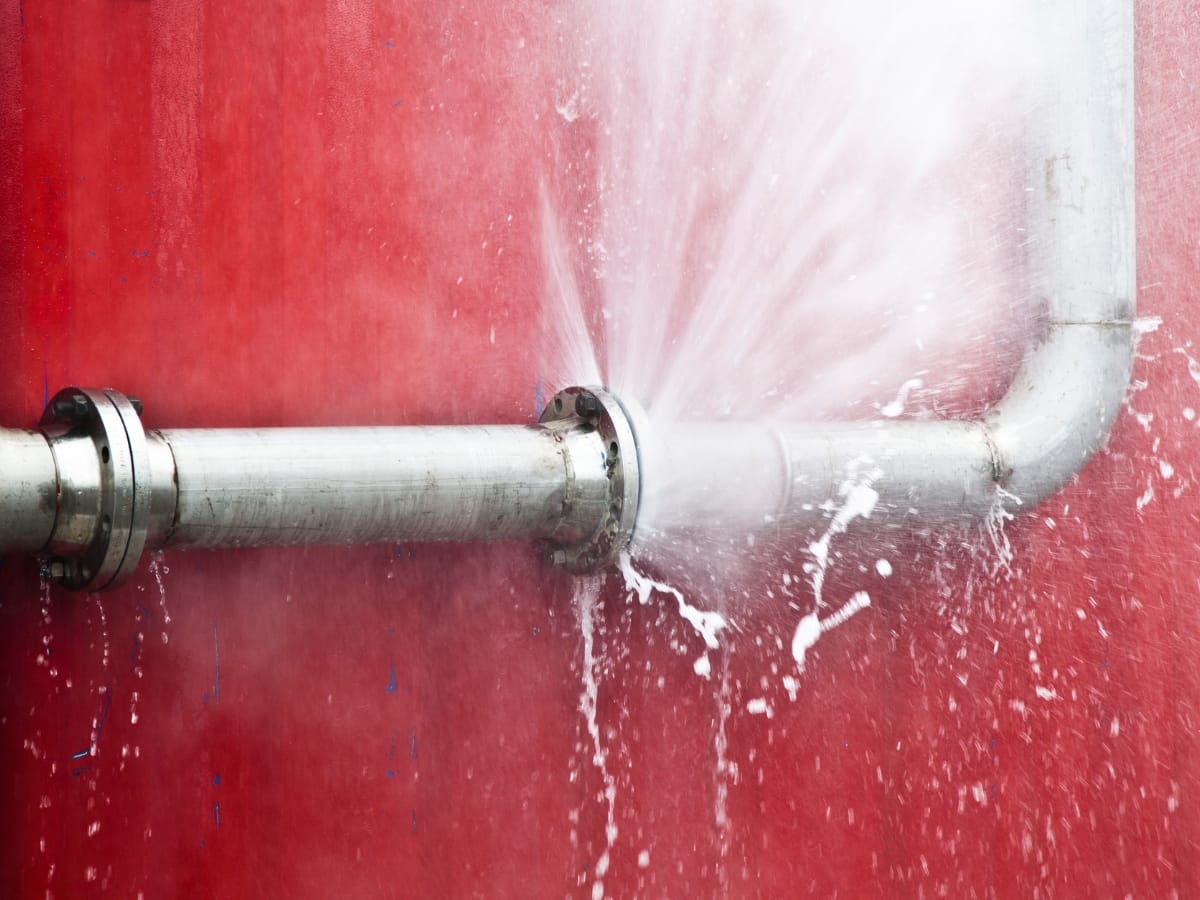
HVAC winterization keeps heat moving where it matters, protects vulnerable plumbing, and spots problems before they turn into soaked ceilings or shut doors. In Atlanta, a mild week can flip to a hard freeze overnight. Consistent space heating, verified airflow, and insulated piping keep water above freezing, reduce expansion stress inside lines, and cut the odds of a burst that halts operations. Done well, HVAC winterization also trims runtime and stabilizes indoor conditions, so you control energy costs while protecting the building.
Best Practices For Insulating And Protecting Commercial Plumbing
Start by identifying exposure. Walk exterior walls, dock areas, stairwells, and unconditioned mechanical rooms, then mark any pipe runs that sit near louvers or thin wall sections. Wrap exposed lines with high-density foam and secure the seams with UV-resistant tape so the insulation stays tight all season. Add heat-trace cable on sections that routinely sit near 32°F, especially above drop ceilings and along north elevations. Insulate valves, backflow preventers, and strainers, and verify that access covers close cleanly after work. Where you have long domestic hot water loops, confirm recirculation pumps operate on cold nights to keep water moving.
How Leak Detection And Prevention Minimize Winter-Related Damage
Finding small leaks early prevents the pressure swings and ice formation that create bigger failures. Schedule a pressure drop test on domestic mains, record baseline readings, and compare them after hours when fixtures are off. Scan pipe chases and ceiling runs with an infrared camera to spot cold bridges, missing insulation, and moisture shadows. Pair these checks with smart meters or inline flow sensors that alert your team when consumption spikes outside normal patterns. When you do find a weep at a fitting, repair it immediately and reinsulate the section so heat loss does not return.
Control Strategies That Reduce Freeze Risk Without Wasting Energy
Controls matter as much as insulation. Calibrate thermostats and confirm sensors sit away from exterior drafts and heat sources. Set unoccupied heating setpoints high enough to protect piping in perimeter zones, typically a couple of degrees below the occupied target, and coordinate schedules with cleaning crews and late shifts. Program earlier morning warm-up on freeze watch days so spaces reach temperature before opening, and keep supply fans and pumps running at low speed overnight in vulnerable areas to maintain air and water movement. If your building automation system supports alarms, set notifications for perimeter temperatures and mechanical room conditions.
A Practical Winterization Plan You Can Repeat Each Year
Document what you do and when you do it. Replace or clean filters first to restore airflow, then seal visible duct gaps and verify insulation on runs that cross unconditioned spaces. Clean coils, check burners or heat strips, and test safeties so equipment shuts down safely if a fault occurs. Insulate and heat-trace exposed piping, label shutoffs, and keep photos of completed work for quick reference. Finish with a freeze drill that lists who to call, where to isolate water, and how to stage portable heaters if a zone dips too low. With consistent HVAC winterization, Atlanta facilities avoid frozen pipes, protect finishes and inventory, and keep business moving when temperatures drop.
How Atlanta Businesses Can Optimize Energy Efficiency Through HVAC Winter Maintenance
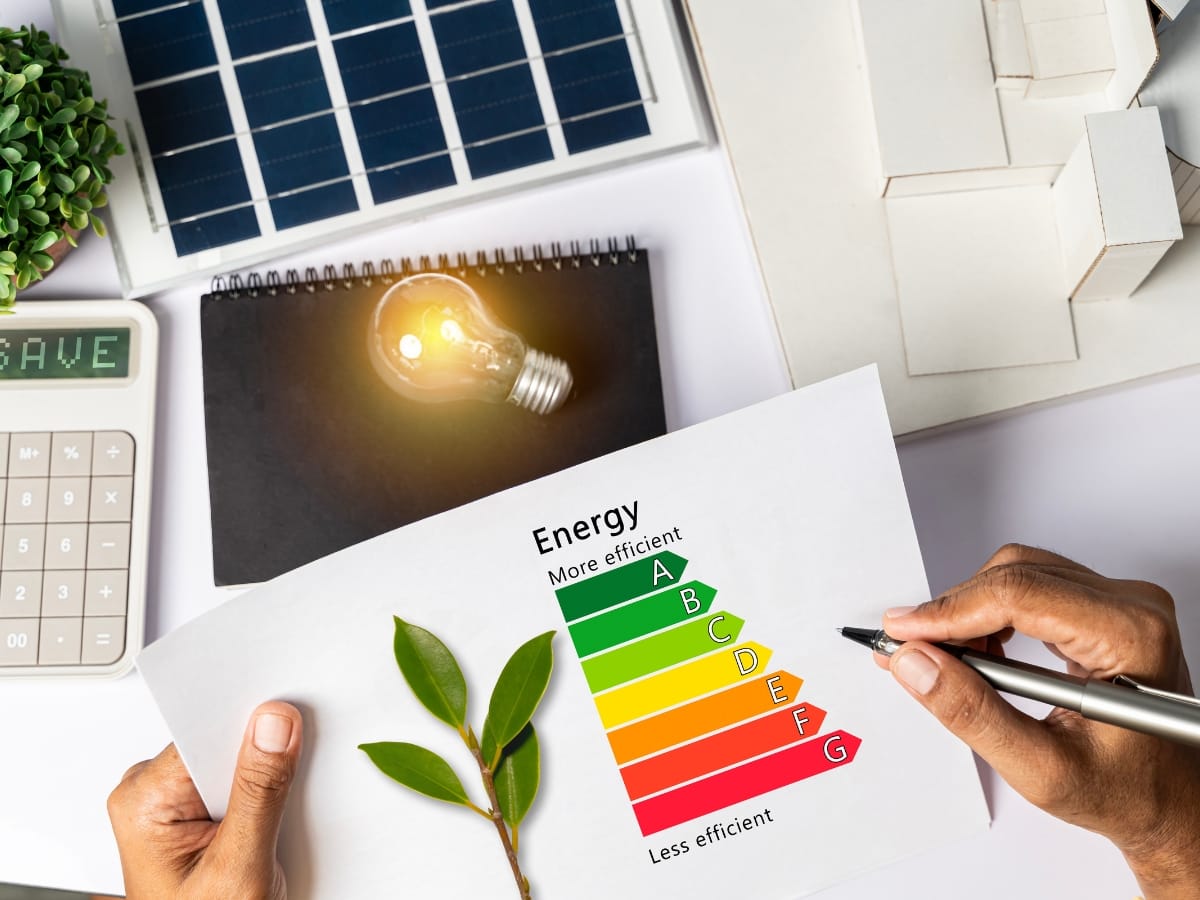
Winter maintenance is one of the fastest ways to lower operating costs without sacrificing comfort. In Atlanta’s swingy cold snaps, small inefficiencies become big bills. Aligning seasonal tune-ups with your broader energy plan keeps equipment clean, calibrated, and protected. It also positions you to capture utility rebates that reward verified performance improvements. Taken together, HVAC winterization stabilizes indoor conditions, reduces runtime, and extends the service life of major components.
The Role Of Smart Thermostats And Programmable Controls In Winter Efficiency
Smart controls help you heat only the spaces that need it and only when they are in use. Create zone schedules that mirror real occupancy, then pair them with lockouts that prevent manual overrides from creeping setpoints upward. Real-time alerts flag unusual temperature drift or short cycling so you can correct issues before they inflate bills. Remote access lets facility teams adjust settings for special events or weather swings without rolling a truck. When schedules, sensors, and setpoints are aligned, buildings typically avoid unnecessary overnight heating and can realize up to an additional 10% in energy savings.
How System Calibration And Insulation Improve Heating Performance
Calibration and insulation tackle the two biggest winter losses: control error and heat escape. Thermostats and sensors should read within 1 °F of actual conditions; anything looser can push equipment to overshoot setpoints. Duct insulation on plenums and main trunks keeps supply air from cooling before it reaches the zone, which improves delivered BTUs and reduces cycle length. Combustion and heat transfer tune-ups on boilers and furnaces restore designed efficiency by cleaning heat exchangers, setting fuel air ratios, and verifying temperature rise.
| Adjustment Type | Component | Typical Efficiency Gain |
|---|---|---|
| Thermostat recalibration | Control sensor | ±1 °F accuracy |
| Duct insulation upgrade | Plenum and main trunks | Up to 8% heat retention |
| Boiler or furnace tuning | Heat exchanger and burners | 5–7% fuel use reduction |
These gains compound when combined with clean filters, balanced airflow, and verified damper operation. The result is steadier temperature, shorter cycles, and fewer nuisance calls.
Integrating Maintenance With Rebates And Measurement
Treat winter work as a measurable project rather than a checklist. Before maintenance, record baseline data such as run hours, supply air temperature, static pressure, and fuel use per heating degree day. After work is complete, re-measure the same points to document improvement. This evidence often supports rebate applications and strengthens internal ROI cases for additional upgrades like high-efficiency motors or controls. Keep simple logs of filter changes, coil cleaning, sealant locations on ducts, and insulation thickness so next season’s team can verify conditions quickly.
A Practical Plan You Can Repeat Each Year
Start early in the fall with airflow fixes and coil cleaning, then move to heating safety checks and control calibration. Insulate or heat trace vulnerable piping and confirm freeze protection setpoints in mechanical rooms and perimeter zones. As temperatures drop, review trend data weekly to catch anomalies and adjust schedules for holidays or partial occupancy.
With a predictable cycle of inspection, adjustment, and verification, HVAC winterization becomes a reliable lever for cost control, comfort, and equipment longevity across your Atlanta portfolio.
Choosing The Right Commercial HVAC Winterization Service In Atlanta

Selecting a partner for HVAC winterization is about more than a seasonal tune-up. You want a contractor with proven commercial experience, a grasp of Atlanta’s weather swings, and the ability to tailor plans to your building type. The right team will prepare equipment for cold snaps, document findings, and align settings with your occupancy so you get reliable heat, steady airflow, and predictable costs.
What Businesses Should Look For In An HVAC Contractor For Winterization
Start with depth of experience. A qualified provider can speak to healthcare, hospitality, office, retail, and mission-critical spaces, since each handles ventilation, pressurization, and redundancy differently. Ask about certifications and ongoing training, such as NATE credentials, ASHRAE membership, manufacturer authorizations, and safety programs that meet OSHA standards.
Local code knowledge matters, as does familiarity with building automation systems and energy benchmarking. A strong contractor also provides transparent scopes that spell out filter grades, coil cleaning methods, combustion analysis, static pressure targets, temperature rise ranges, glycol concentration checks, and pipe freeze protection. Finally, request references from facilities similar to yours so you can verify performance during previous winters.
How Expert Teams Deliver Winterization And Emergency Support
An expert winterization visit begins with airflow restoration, continues through heating safety, and finishes with controls and freeze protection. Technicians replace or clean filters to the specified MERV rating, seal visible duct leaks, and clean evaporator and condenser surfaces to recover heat transfer.
On furnaces and boilers, they confirm ignition reliability, inspect heat exchangers, verify relief valves, and document temperature rise or flue draft. Heat pumps get coil cleaning, defrost cycle testing, and charge verification. Controls are calibrated so sensors read accurately, schedules match real occupancy, and perimeter zones hold protective setpoints overnight.
Vulnerable piping is insulated or heat-traced, mechanical rooms are checked for minimum temperatures, and shutoff points are labeled for quick isolation if a line is threatened by a hard freeze. For peace of mind, look for true 24/7 coverage with defined response times, stocked critical spares, and access to rental heat or mobile boilers when a major component is offline.
How To Compare Proposals And Service Agreements
Make sure proposals are apples to apples. A comprehensive plan lists specific tasks, measurement points, and reporting you will receive after each visit. Look for documented readings such as supply air temperature, return temperature, static pressure, combustion efficiency, and building automation alarms cleared and tested.
Preventive maintenance agreements should outline seasonal visits, priority scheduling, fixed pricing for inspections, and clear time and material rates for corrective work. Solid contracts include a communication plan that names the primary technician, the service manager, and the escalation path, plus a spare parts strategy for items like belts, contactors, sensors, and filter sets.
Energy support is a bonus, especially if the provider helps you align winter work with utility rebates, verifies savings with before and after data, and updates control sequences to reduce after-hours run time.
Questions That Help You Choose With Confidence
Ask how the contractor protects plumbing during cold snaps, which setpoints they use for perimeter zones, and how they monitor trends to catch issues early. Confirm that technicians will photograph repairs, tag insulated piping, and leave a simple freeze response checklist at each mechanical room. With a clear scope, measured results, and strong emergency coverage, your HVAC winterization program will lower risk, curb energy use, and keep your Atlanta facility comfortable all season.
Conclusion
Don’t let unexpected HVAC failures disrupt your business this winter. Proactive commercial winterization is a strategic investment that ensures operational continuity, protects your bottom line, and maintains a comfortable environment for employees and customers alike. At Galgon HVAC & Mechanical Service, we provide comprehensive winterization HVAC services tailored to Atlanta’s unique climate, helping you avoid costly repairs and maximize system efficiency throughout the coldest months. Secure your facility today: Call (404) 352-1500 or request a service quote online—and experience the peace of mind that comes with a professionally maintained HVAC system.
